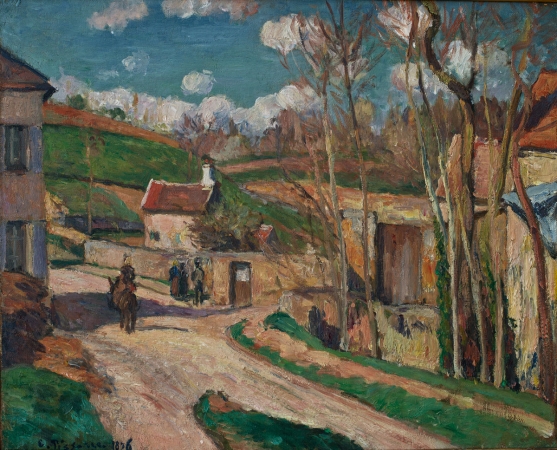PISSARRO, Crossroads at L'Hermitage, Pointoise

Camille PISSARRO (1831-1903)
Crossroads at L'Hermitage, Pointoise
1876
oil on canvas
38.5 x 46.5 cm
© MuMa Le Havre / David Fogel
Crossroads at L'Hermitage, Pointoise
1876
oil on canvas
38.5 x 46.5 cm
© MuMa Le Havre / David Fogel
HD image
During the war of 1870, Pissarro left France and set sail for England, where he discovered the work of Turner during visits to the National Gallery with Monet, who had also taken refuge across the Channel. The luminous magic of Turner's skies, his poetic interpretation of the weather and Monet’s use of small, rapid brushstrokes, his explorations into light and his reflections on the water are often cited as explanations of Pissarro's new approach to nature.
Back on French soil, bolstered by his new experiences, he left Louveciennes for L'Hermitage from 1872 to 1882. He grew attached to the simple motifs of a road leading to the village, the peaceful work of the farmers, the patchwork of fields on the hills, the changing colours of the seasons that give rhythm to this tranquil place.
In Crossroads at L'Hermitage, Pointoise, a few figures go about their daily life at a crossroads, as a bright sky dotted with plump clouds gives the autumn colours vibrancy. The composition is squarely set between the curtain of trees along the path to the right and the large, partially hidden building on the far left. The horizon line is thrown to the top of the canvas above the hills. By doing so, Pissarro disregards the matter of atmospheric effects so dear to Claude Monet, to concentrate on structuring and harmonizing the different planes into areas of vivid colour. A rhythm is established between the green of the fields cultivated on the hill and the reddish browns of the ploughed soil and the path.
Never had Pissarro achieved such a strong vibrancy of colour, adding orangey hues on the tiled roofs to bring out the brightness of the painting as a whole. He ceased striving to capture the immobility of the moment to develop a quick and tumultuous style that yields to the dazzle of the light-filled colour so typical of his work painted at Éragny.
Back on French soil, bolstered by his new experiences, he left Louveciennes for L'Hermitage from 1872 to 1882. He grew attached to the simple motifs of a road leading to the village, the peaceful work of the farmers, the patchwork of fields on the hills, the changing colours of the seasons that give rhythm to this tranquil place.
In Crossroads at L'Hermitage, Pointoise, a few figures go about their daily life at a crossroads, as a bright sky dotted with plump clouds gives the autumn colours vibrancy. The composition is squarely set between the curtain of trees along the path to the right and the large, partially hidden building on the far left. The horizon line is thrown to the top of the canvas above the hills. By doing so, Pissarro disregards the matter of atmospheric effects so dear to Claude Monet, to concentrate on structuring and harmonizing the different planes into areas of vivid colour. A rhythm is established between the green of the fields cultivated on the hill and the reddish browns of the ploughed soil and the path.
Never had Pissarro achieved such a strong vibrancy of colour, adding orangey hues on the tiled roofs to bring out the brightness of the painting as a whole. He ceased striving to capture the immobility of the moment to develop a quick and tumultuous style that yields to the dazzle of the light-filled colour so typical of his work painted at Éragny.
























